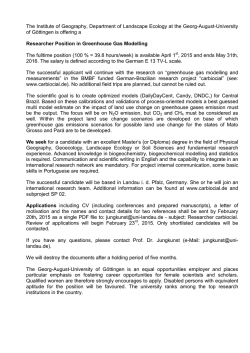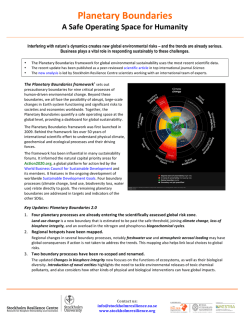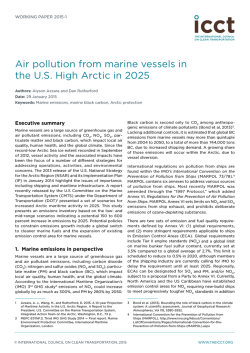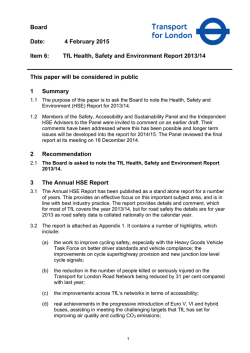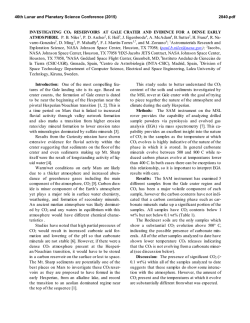
La economía española emitió 324,2 millones de toneladas de gases
16 November 2016 Environmental accounts. Air Emission Accounts. Base 2010. Accounting series 2010 – 2014 In 2014, the Spanish economy emits 324.2 million tonnes of greenhouse gases, 0.2% more than in 2013 In the 2010-2014 period, emissions have been reduced by 8.9% Greenhouse gas (GHG) emissions into the atmosphere increased by 0.2% in 2014, as compared with the previous year, reaching 324.2 million tonnes of equivalent CO2 (tCO2e) 1. In the period 2010-2014, emissions were reduced by 8.9%. Greenhouse gases Total emissions Unit: millions of tonnes of equivalent CO2 (tCO2e) 400.0 356.0 356.1 351.5 350.0 323.4 324.2 2013 2014 300.0 250.0 200.0 150.0 100.0 50.0 0.0 2010 2011 2012 1 In order to compare the atmospheric emissions, greenhouse gas emissions, other than carbon dioxide are transformed into their equivalent value of carbon dioxide (CO2e) multiplying the mass of the gas in question by its global warming potential. AEA - YEAR 2014 (1/6) Results by branches of activity and households The sectors that reduced their emissions the most in 2014 were Electricity, gas, steam, air conditioning, and water supply (4.8%) and Agriculture, forestry and fishing (2.1%). Households, as final consumers, increased their emissions by 2.7%. Greenhouse gas emissions by branches of economic activity and households Unit: thousands of tonnes of equivalent CO2 12.6 % interannual variation 2.1 3,200.5 1.0 -2.6 83,291.6 25.7 -1.4 76,977.1 23.8 4.8 1,025.0 0.3 -4.4 Transport and storage Other services 34,164.6 10.5 -6.9 14,214.1 4.4 -10.0 Households 70,375.2 21.7 2.7 324,171.3 100.0 0.2 2014 Agriculture, forestry and fishing % over the total 40,923.3 Extractive industry Manufacturing industry Electricity, gas, steam and air conditioning supply Construction TOTAL Greenhouse gas emissions were mainly due to Manufacturing industry, which concentrated 25.7% of the total number of emissions in 2014. In turn, Electricity, gas, steam, air conditioning, and water supply emitted 23.8% of the total, and households did so by 21.7%. Greenhouse gas emissions Percentage structure in 2014 25.7 Manufacturing industry 23.8 Electricity, gas, steam and air conditioning supply 21.7 Households 12.6 Agriculture, forestry and fishing 10.5 Transport and storage 4.4 Other services Extractive industry Construction 1.0 0.3 AEA - YEAR 2014 (2/6) Emissions by type of gas There are different types of greenhouse gases. By level of emission, the main greenhouse gases are carbon dioxide (CO2), methane (CH4) and nitrous oxide (N2O). CO2 - carbon dioxide atmospheric emissions increased by 0.4% in 2014, as compared with 2013. Within the 2010-2014 period, those emissions were reduced by 10.5%. In 2014, CH4 - methane emissions increased by 0.2%. Within the 2010-2014 period, those emissions were reduced by 2.0%. In turn, N2O - nitrous oxide emissions increased by 4.0% in 2014 and decreased by 1.5% within the 2010-2014 period. Greenhouse gas emissions by type of gas Unit: thousands of tonnes of equivalent CO2 % over the total % interannual variation % variation of 2010 259,449.6 80.0 0.4 -10.5 32,062.8 9.9 0.2 -2.0 14,289.0 18,370.0 324,171.3 4.4 5.7 100.0 4.1 -4.5 0.2 -1.5 -3.1 -8.9 2014 CO2 - Carbon dioxide CH4 - Methane N2O - Nitrous oxide Other GHG TOTAL Greenhouse gas emissions Variation index. Reference year 2010 = 100 120.0 100.0 100.0 99.6 104.3 95.9 105.9 98.6 98.3 92.6 97.8 89.2 101.4 94.7 98.0 98.5 96.9 89.5 80.0 60.0 40.0 20.0 0.0 2011 2012 CO2 - Carbon dioxide 2013 CH4 - Methane N2O - Nitrous oxide 2014 Other GHG AEA - YEAR 2014 (3/6) Carbon dioxide, methane and nitrous oxide emissions by branch of activity In 2014, the greatest quantities of carbon dioxide (CO2) emitted corresponded to Manufacturing industry, which emitted 75.5 million tonnes, Supply of electrical energy, gas, steam, air conditioning and water, which emitted 62.4 million tonnes of CO2, and households, which emitted 62.1 million. As a whole, they represented 77.0% of the total of CO2 atmospheric emissions. Agriculture, cattle breeding, forestry and fishing emitted the highest quantities of methane (CH4) and nitrous oxide (N2O) in 2014. More specifically, it was 17.4 million tonnes of CO2 of equivalent CH4 (54.3% of the total) and 10.3 million of tCO2e of equivalent N2O (72.0%). Supply of electrical energy, gas, steam, air conditioning and water was responsible for the emission of 12.4 million of tCO2e of equivalent CH4 and 1.8 million of tCO2e of equivalent N2O, representing 38.8% and 12.6% of the total emissions of these gases, respectively. Emissions of carbon dioxide (CO2), methane (CH4) and nitrous oxide (N2O) Total emissions. Year 2014 Unit: thousands of tonnes of carbon dioxide equivalent (tCO2e) Carbon dioxide Agriculture, forestry and fishing Extractive industry Manufacturing industry Electricity, gas, steam and air conditioning supply Construction Transport and storage Other services Households TOTAL 12,896.1 Methane 17,415.9 Nitrous oxide 10,290.5 2,566.4 244.3 28.6 75,513.5 1,100.6 753.2 62,376.7 12,433.9 1,801.0 600.5 0.1 6.6 33,458.6 28.3 318.9 9,935.4 63.0 437.1 62,102.5 776.7 653.1 259,449.6 32,062.8 14,289.0 AEA - YEAR 2014 (4/6) Emissions of carbon dioxide (CO2), methane (CH4) and nitrous oxide (N2O) Percentage structure (year 2014) CO2 - Carbon dioxide 29.1 Manufacturing industry Electricity, gas, steam and air conditioning supply 24.1 Households 23.9 12.9 Transport and storage 5.0 Agriculture, forestry and fishing 3.8 Other services 1.0 Extractive industry Construction 0.2 CH4 - Methane 54.3 Agriculture, forestry and fishing 38.8 Electricity, gas, steam and air conditioning supply 3.4 Manufacturing industry 2.4 Households Extractive industry 0.8 Other services 0.2 Transport and storage 0.1 Construction 0.0 N2O - Nitrous oxide 72.0 Agriculture, forestry and fishing 12.6 Electricity, gas, steam and air conditioning supply Manufacturing industry 5.3 Households 4.6 Other services 3.1 Transport and storage 2.2 Extractive industry 0.2 Construction 0.0 AEA - YEAR 2014 (5/6) Methodological note The National Statistical Institute presents today the estimations corresponding to the period 2010-2014 of the Atmospheric Emission Accounts base 2010. The Environmental Accounts (EA) are a synthesis statistical option with the general objective of integrating environmental information coherently in the central system of National Accounts, following the methodology of the United Nations' System of Integrated Environmental and Economic Accounting (UNSD), which constitutes the conceptual framework of the EA. Regulation (EU) No 691/2011 of the European Parliament and of the Council of 6 July 2011 on European environmental economic accounts, constitutes the reference framework of concepts, definitions, classifications, and common accounting regulations whose purpose is to draft Environmental accounts and incorporates a module on this account, for annual transmission. The Air Emission Accounts present the data regarding the polluting emissions into the atmosphere, in a way that is compatible with the System of National Accounts, registering the emitting agents, broken down by branch of economic activity and Households as final consumers. The estimates of the Air Emission Accounts are carried out using the National Air Emission Inventories, compiled by the Ministry of Agriculture, Food and the Environment, using the EMEP/CORINAIR methodology developed by the European Environmental Agency, with the SNAP nomenclature (Selected Nomenclature for Air Pollution), which groups emissions functionally, by process. The Inventories present the emissions of all of the sources in the country, regardless of whether they are domestic economic activities (principle of residence) or not. Moreover, it includes the emissions of non-economic agents (nature) and the absorption of substances by nature (carbon by biomass). In order to prepare the estimates for the Emission Account, it is necessary to adapt the emissions to the principles of the System of National Accounts. Regarding the distribution, by branch of activity and Households as final consumers, most of the inventory categories correspond to a single economic activity registered in a branch of activity, but in certain cases, the emissions must be divided into several branches (combustion plants, transport and other). Since atmospheric emissions are distributed by branch of economic activity in accordance with the rules of the National Accounts system, those resulting from secondary and auxiliary activities are grouped with those of the main activity of economic units. Households as final consumers considers the direct emissions corresponding to their own transport, heating and other emissions of a secondary nature. For further information see INEbase-www.ine.es/en/ All press releases at: www.ine.es/en/prensa/prensa_en.htm Press Office: Telephone numbers: 91 583 93 63 / 94 08 – Fax: 91 583 90 87 - [email protected] Information Area: Telephone number: 91 583 91 00 – Fax: 91 583 91 58 – www.ine.es/infoine/?L=1 AEA - YEAR 2014 (6/6)
© Copyright 2026
